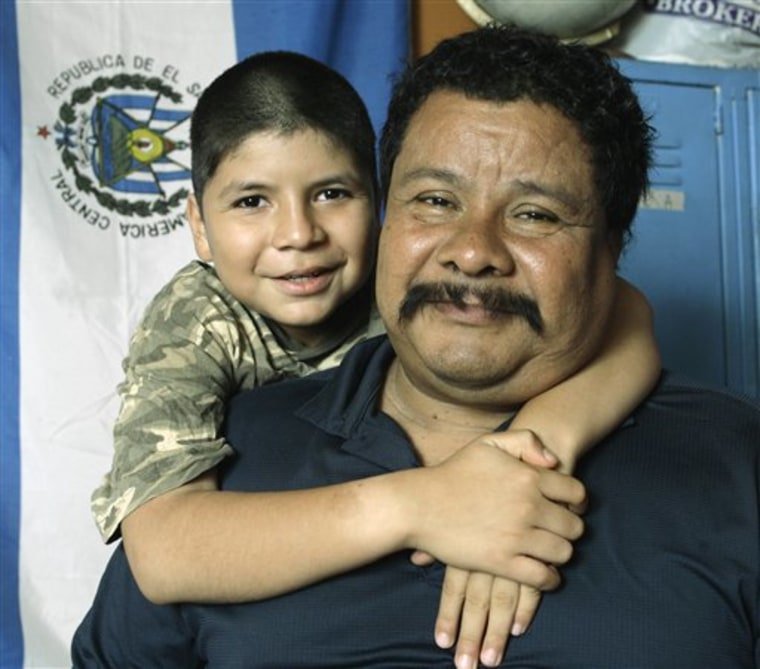The Obama administration's plan to stop holding immigrant families at a former central Texas prison was cheered Thursday by the immigrants' supporters and some in Congress as a needed change in inhumane and sometimes deadly detentions.
Supporters of tougher immigration enforcement, however, questioned whether the administration was returning to policies that allow immigrants to disappear. And even those who liked the changes said the government needs to go further and write detention standards into law.
John Morton, Immigration and Customs Enforcement director, told reporters Thursday that detentions of families at the T. Don Hutto Residential Center in Taylor, Texas, which has held 400 people, would end immediately.
Some families would go to a facility in Pennsylvania, but it has only 85 beds and Morton said other alternatives would be considered. These could include community homes, often run by nonprofit or religious groups, where the immigrants can come and go, but federal officials can still keep track of them.
The decision was among several first steps that Morton said eventually would "lead to ... creation of a system that is marked by and driven by the civil detention philosophy." He said these changes can be made while still detaining immigrants who are criminals or dangerous.
‘About how we detain’
"We are going to continue to detain on a large scale," he said. "This is about how we detain."
Homeland Security Secretary Janet Napolitano said more changes are coming in what she called a major overhaul that DHS officials acknowledge will take years.
"There are a number of issues that need to be corrected," Napolitano said. "If people are going to be held ... we have an obligation that they be held safely in a clean, healthy environment."
At the Texas facility, families were locked in cells equipped with bunk beds and a toilet. Immigration advocates considered the site a symbol of inhumanity in the country's immigration detention. A lawsuit filed by the American Civil Liberties Union forced changes to the facility, such as allowing families to have more time to eat and removing concertina wire that surrounded the facility.
ACLU of Texas Legal Director Lisa Graybill said her group is "overjoyed" the administration recognized holding children in the facility is "inhumane and un-American." But she said the "victory does not eclipse" the fact the federal government spends hundreds of millions of dollars to detain immigrants when less expensive alternatives are available.
The annual cost of detaining immigrants has reached $1.7 billion, according to ICE.
Other advocates said Congress must write immigration detention standards into law to make them enforceable.
Legislation to improve conditions
Separate bills have been filed by Sens. Bob Menendez, D-N.J., and Joe Lieberman, I-Conn., who chairs the Homeland Security and Government Affairs committee, to improve detention conditions.
The number of detained immigrants has risen sharply in recent years and the detention system has not kept pace in ensuring humane conditions, proper medical treatment, or basic legal protections, Lieberman said.
Marcos Marquez, a Salvadoran who took trains and hitchhiked his way through Central America, spent eight months in Hutto. Marquez said it was hard to hear children at the detention center asking to go to the store, although the conditions were the best he'd ever lived in.
"The mom would say, 'No, we're not allowed to leave' and the kids would say, 'We're in jail aren't we, Mom?'" Marquez said. "That was really heartbreaking, to hear the kids, because the kids would then cry, then the moms would cry."
He added his 10-year-old son, also Marcos, didn't understand why they were in jail but played video games, made friends, got classroom instruction and was never forcibly separated from his father at the center.
The detention system expanded after the Sept. 11, 2001, terrorist attacks as the Bush administration stepped up immigration enforcement and ended a policy of releasing illegal immigrants into the country to await deportation hearings — a practice known as "catch and release."
Praise for ‘catch and release’
Texas Rep. Lamar Smith, the ranking Republican on the House Judiciary Committee, praised attempts treat immigration detainees more humanely. But he said he's concerned families may be broken up and the government will return to "catch and release."
"I hope that the Obama administration will not repeat past mistakes and return to a policy that puts more illegal immigrants on the streets of American communities," Smith said.
ICE holds about 32,000 detainees in detention facilities provided through contracts with private companies, local communities and states or in a few federally owned facilities.
The system is spread over more than 350 facilities designed for criminal rather than civil detention, Morton said. Entering the country illegally for the first time is a civil violation.
Morton also announced that Dora Schiriro, former Arizona's corrections chief, will direct an Office of Detention Policy and Planning and an office of detention oversight will be created to conduct routine, random inspections and deal with grievances and allegations of misconduct.
Morton said the changes are based on his understanding of the people ICE detains.
"They want to be near their family, their lawyers and have access to other resources they need while they are going through immigration proceedings," he said. "Many of the people in our custody are not criminals and don't want to be treated as such."
